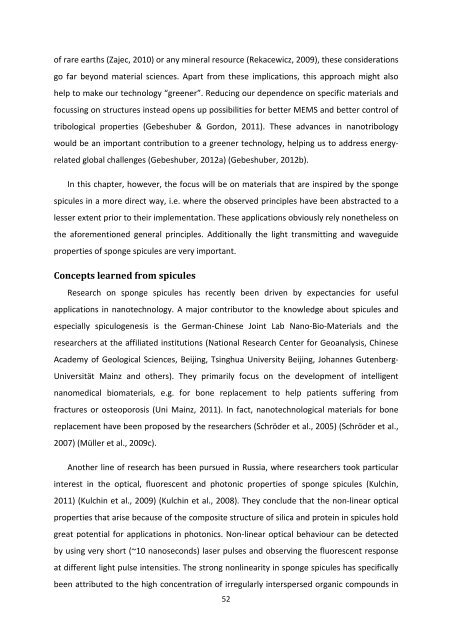MASTER THESIS Biomimetic potential of sponge ... - IAP/TU Wien
MASTER THESIS Biomimetic potential of sponge ... - IAP/TU Wien
MASTER THESIS Biomimetic potential of sponge ... - IAP/TU Wien
Create successful ePaper yourself
Turn your PDF publications into a flip-book with our unique Google optimized e-Paper software.
<strong>of</strong> rare earths (Zajec, 2010) or any mineral resource (Rekacewicz, 2009), these considerations<br />
go far beyond material sciences. Apart from these implications, this approach might also<br />
help to make our technology “greener”. Reducing our dependence on specific materials and<br />
focussing on structures instead opens up possibilities for better MEMS and better control <strong>of</strong><br />
tribological properties (Gebeshuber & Gordon, 2011). These advances in nanotribology<br />
would be an important contribution to a greener technology, helping us to address energyrelated<br />
global challenges (Gebeshuber, 2012a) (Gebeshuber, 2012b).<br />
In this chapter, however, the focus will be on materials that are inspired by the <strong>sponge</strong><br />
spicules in a more direct way, i.e. where the observed principles have been abstracted to a<br />
lesser extent prior to their implementation. These applications obviously rely nonetheless on<br />
the aforementioned general principles. Additionally the light transmitting and waveguide<br />
properties <strong>of</strong> <strong>sponge</strong> spicules are very important.<br />
Concepts learned from spicules<br />
Research on <strong>sponge</strong> spicules has recently been driven by expectancies for useful<br />
applications in nanotechnology. A major contributor to the knowledge about spicules and<br />
especially spiculogenesis is the German-Chinese Joint Lab Nano-Bio-Materials and the<br />
researchers at the affiliated institutions (National Research Center for Geoanalysis, Chinese<br />
Academy <strong>of</strong> Geological Sciences, Beijing, Tsinghua University Beijing, Johannes Gutenberg-<br />
Universität Mainz and others). They primarily focus on the development <strong>of</strong> intelligent<br />
nanomedical biomaterials, e.g. for bone replacement to help patients suffering from<br />
fractures or osteoporosis (Uni Mainz, 2011). In fact, nanotechnological materials for bone<br />
replacement have been proposed by the researchers (Schröder et al., 2005) (Schröder et al.,<br />
2007) (Müller et al., 2009c).<br />
Another line <strong>of</strong> research has been pursued in Russia, where researchers took particular<br />
interest in the optical, fluorescent and photonic properties <strong>of</strong> <strong>sponge</strong> spicules (Kulchin,<br />
2011) (Kulchin et al., 2009) (Kulchin et al., 2008). They conclude that the non-linear optical<br />
properties that arise because <strong>of</strong> the composite structure <strong>of</strong> silica and protein in spicules hold<br />
great <strong>potential</strong> for applications in photonics. Non-linear optical behaviour can be detected<br />
by using very short (~10 nanoseconds) laser pulses and observing the fluorescent response<br />
at different light pulse intensities. The strong nonlinearity in <strong>sponge</strong> spicules has specifically<br />
been attributed to the high concentration <strong>of</strong> irregularly interspersed organic compounds in<br />
52

















